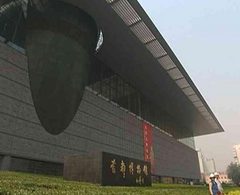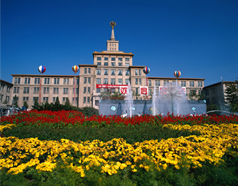
Beijng Museums
By china tour on 2009-9-28 20:36:00 | Beijing Tours
 Beijing has been the capital city of China for almost 900 years which provides it a very convenient opportunity in witnessing the changes of time and history in china. As the center of politics, economy and culture. Beijing is much more an old book full of the years Changes and deposit of history and culture instead of a city itself. The museum, seen as the freeze history, is the place for recording and collecting the progress of human civilization. As a nation with great future, she must have strong feelings of cherishing her own history. The latest statistics say that the number of the museums in Beijing has ranked the second in the word just next to London. The numerous museums in Beijing have formed a unique cultural landscape and make this history- rich country a more dense humanitarian breath.At present, Beijing is the home to more than 100 museums and we have listed some valuable ones for you to check out.
Beijing has been the capital city of China for almost 900 years which provides it a very convenient opportunity in witnessing the changes of time and history in china. As the center of politics, economy and culture. Beijing is much more an old book full of the years Changes and deposit of history and culture instead of a city itself. The museum, seen as the freeze history, is the place for recording and collecting the progress of human civilization. As a nation with great future, she must have strong feelings of cherishing her own history. The latest statistics say that the number of the museums in Beijing has ranked the second in the word just next to London. The numerous museums in Beijing have formed a unique cultural landscape and make this history- rich country a more dense humanitarian breath.At present, Beijing is the home to more than 100 museums and we have listed some valuable ones for you to check out.
 Museum of Natural History
Museum of Natural History
Beijing Museum of Natural History grew out of the preparation department of National Central Museum of Natural History founded in 1951. Beijing Museum of Natural History was formally named in 1962. Being the first large-scale museum of natural history founded on our own strength after new China was established, the museum bears three main functions: the specimen collection, the academic research and the science popularization of paleontology, zoology, botany and anthropology. The museum today boasts its rich collections, high-level research and ever-enlarging exhibitions. It has been one of a few museums of natural history in China and named as National Youth Science and Technology Education Base
Working Time: 9:00-17:00
Open: 6 days a week(Except Monday).
Group Reserve: more than 20 persons.
Address: 126, Tianqiao ST, Beijing,100050,PRC
Reserve Tel: 010-67024439,67024435(group);67024431,67020733(individual)
Fax:010-67021254
the Museum of Chinese History
The predecessor of the Museum of Chinese History is the Beijing History Museum built in 1912 and was opened to the public in October 1926. In August 1958, the Chinese government decided to establish a new national museum on the eastern side of Tian'anmen Square. The construction was completed in October 1959. The Museum of Chinese History displays three main periods of Chinese history. The first, the Primitive Society, spans from 500,000BC to 4,000BC. The exhibits in the Slavery Society section cover the time from 2,100BC to 475BC and the Feudal Society exhibits focus on the period from 221BC to 1911.Many of the items on display are national treasures and precious rarities.
Open: 8:30 -- 16:30 (Last Entry at 15:00) for March 1 - June 30
8:00 -- 18:00 (Last Entry at 17:00) for July 1 - August 31
8:30 -- 16:30 (Last Entry at 15:00) for September 1 - October 31
9:00 -- 16:00 (Last Entry at 15:00) for November 1 - February 29
Admission: 30 yuan
Tel: 8610-6512 8901
The Museum of the Chinese Revolution
The Museum of the Chinese Revolution emphasizes the history of the past 150 years, in particular the history of the Communist Party of China. It is divided into three sections. The exhibits in the Old Democratic Revolution section cover the period from 1840 to 1911. Events between 1911 and 1949 fall into the New Democratic Revolution section. The third section is entitled "The Triumph of the Revolution and the Establishment of Socialism" and covers events after 1949.Much of China's modern history is exhibited, including the founding of the Chinese Communist Party (1919-1921), the first two civil wars (1924-1927 and 1927-1937), the resistance war against Japanese aggression (1937-1945) and the liberation war (1945-1949). The museum is frequently updated to reflect the developments of modern political history.
Open: 8:30 -- 16:30 (Last Entry at 15:00) for March 1 - June 30
8:00 -- 18:00 (Last Entry at 17:00) for July 1 - August 31
8:30 -- 16:30 (Last Entry at 15:00) for September 1 - October 31
9:00 -- 16:00 (Last Entry at 15:00) for November 1 - February 29
Admission: 30 yuan
Tel: 8610-6512 8901
The Chinese Military Museum
The Chinese Military Museum is located near the Yuyuan Pool (the Deep Jade Pool). Its structural area takes up about 6,000 square metres and its exhibition area is more than 4,000 square metres. In the central hall of the museum stands a white, marble statue of Mao Zedong that stands four metres high. There are four pairs of exhibition halls, including sections on the Second Civil Revolutionary War, the War of Resistance Against Japan, the Third Civil Revolutionary War, and protecting socialism. The weapons exhibited in the Arms Hall include those from ancient China, weapons used by the People's Liberation Army during the war of liberation, those used or captured on the country's frontiers or coast and weapons made exclusively by China. The content is full and accurate.
Address: No. 9 Fuxing Road, Haidian District
Tel: 6618 4080
Opening times: 8:30-16:30
The Palace Musuem
Established in 1925, the Palace Museum was installed in the imperial palace of two consecutive dynasties - the Ming (1368-1644) and the Qing (1644-1911). The magnificent architecture, also known as the Forbidden City, and the vast holding of the imperial collections of paintings, calligraphy, ceramics, and decorative objects make it one of the most prestigious museums in China and the world at large. In 1961 the imperial palace was designated by the State Council as one of China's foremost-protected cultural heritage sites, and in 1987 was made a UNESCO World Heritage site.
Open daily all year.
April 1st—October 31 8:30—17:00
Last Entry at 16:10
Tickets sold until 16:00
November 1st—March 31 8:30—16:30
Last Entry at 15:40
Tickets sold until 15:30
China Science & Technology Museum
The Museum of Chinese Science and Technology on northern section of the 3rd Ring Road presents both permanent and short-term exhibitions. It was opened to the public in September 1988. As a national museum of science and technology, it is an important front of popular science education in China, whose main task is to disseminate knowledge of science and technology among the public, and help increase the scientific and cultural literacy of all citizens.
The activities of China Science and Technology Museum include popular science exhibitions, Astro-vision film shows, training-based education programs and experiment-based exhibition programs. The museum covers an area of 40,000 square meters, of which 16,000 square meters is for exhibition halls.
Further Information:
Address: No 1, Beisanhuan Zhonglu, Beijing. 100006
Open: 9:00 - 16: 30. (Closed on Monday but open during national holidays)
Admission: Exhibition hall A: 30 yuan for adult; 20 yuan for student.
Exhibition hall B: 30 yuan for adult; 15 yuan for student.
Exhibition hall C: 10 yuan for adult; 20 yuan for children.
Tel: 8610-62371177-2109
Beijing Aviation Museum
The Beijing Aviation Museum Affiliated to China Aviation Association, located inside the campus of Beijing University of Aeronautics and Astronautics, is the first aviation museum in China. It used to be an airplane show room for teaching practice and reference for aircraft structure design.
In March 1985, the show room was turned into an aviation museum. On October 25, 1986, it was opened to the public. The task of the museum is to support the teaching and popularize the scientific and technical knowledge of aviation.
The museum, divided into the indoor and outdoor exhibition areas, occupies a space of 9,700 square meters. The indoor exhibition area consists of two halls, the east and the west, with a total area of 600 square meters, while the outdoor exhibition area occupies a space of 8,500 square meters.
Further Information:
Address: No. 37 Xueyuan Road, Haidian District
Open: 8:30 -- 12:00; 14:00 -- 17:00 (Tuesday -- Sunday)
Admission: 4 yuan
Tel: 82317513
The Capital Museum
The former Capital Museum, which was located in the Confucius Temple, started its planning stage in 1953 and formally opened to the general public in 1981. As a major cultural construction project in Beijing in the "10th Five-Year Plan", the new Capital Museum, approved by Beijing Municipal Government in 1999, further approved by the State Council after being submitted by the National Development and Reform Commission in 2001, finally commenced its construction in December 2001.As a modern general museum, the Capital Museum will put effort in contributing to enrich people's spiritual life, enhancing cultural exchanges with foreign countries and speeding the socialistic cultural building of Beijing.
Admission: the museum is free of charge now, However, you have to make a reservation at least 3 days before
Open: 9:00-16:00 Tuesday–Sunday
Booking Procedures | Terms & Conditions | Payment Methods | Links | Site Map | About Us | Contact Us | Travel Agent
Copyright 2008, All rights reserved.. itourbeijing.com professional Beijing tour operator and China travel service
TEL: 86-10-85711972 (Universal) 1-888-288-9328 (North America) E-mail: contact@itourbeijng.com
Tours Index | China Tours | Beijing Tours | Xi'an Tours | Shanghai Tours | Guilin Tours | Tibet Tours
China Travel | Beijing Travel | Shanghai Travel | Xi'an Travel | Guilin Travel |The Great Wall Tours
China Golf | Beijing Golf | Shanghai Golf | Xiamen Golf | Beijing Map | Beijing Side Trip | Yangtze Cruise | Travel Picture

